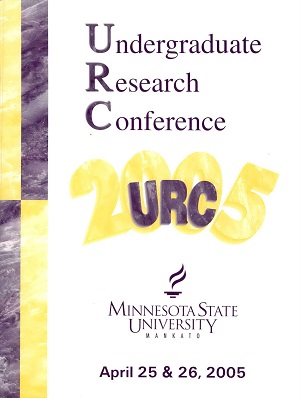Investigation of a Possible Association between Waterfowl Deaths at Lake Onalaska and a Neorickettsiales-Like Organism
Location
CSU 285
Start Date
26-4-2005 10:30 AM
End Date
26-4-2005 11:45 AM
Student's Major
Cross-Disciplinary Studies
Mentor's Name
Robert Sorenson
Mentor's Department
Biological Sciences
Mentor's College
Science, Engineering and Technology
Second Mentor's Name
Timothy Secott
Second Mentor's Department
Biological Sciences
Second Mentor's College
Science, Engineering and Technology
Description
American coots (Fulica americana) and diving ducks, including lesser scaup (Aythya affinis) and ring-necked ducks (Aythya collaris) have been dying in significant numbers on Lake Onalaska since 2001. Bird mortality is being attributed to parasitic infections from two intestinal trematodes, Cyathocotyle bushiensis and Sphaeridiotrema globulus. The birds begin dying in as little as two weeks of landing at this lake. Rapid mortality is not typically associated with trematode parasitism. Assuming these birds acquired their infections at Lake Onalaska, leads to the conclusion that our current understanding of the disease in this parasite-host system is lacking. Neorickettsiales are a group of pathogenic obligately-parasitic intracellular bacteria that are frequently linked to trematode infections involving invertebrate hosts. There is evidence of Neorickettsiales in Bithynia snails, which is also a necessary host to both trematode species, which suggests a possible link between Neorickettsiales and the unusual mortality in the system at Lake Onalaska. Any conservation management practices that can be applied towards curbing this wildlife epidemic will only start with a complete understanding of all the casual factors. Fluorescent-bound antibodies were used to search out Neorickettsiales antigens. Prepared tissue sections from infected trematode-infected birds were analyzed with fluorescent microscopy for the presence of Neorickettsiales-like organisms. At this time, results are inconclusive. Tests are continuing and better quality specimens are being obtained.
Investigation of a Possible Association between Waterfowl Deaths at Lake Onalaska and a Neorickettsiales-Like Organism
CSU 285
American coots (Fulica americana) and diving ducks, including lesser scaup (Aythya affinis) and ring-necked ducks (Aythya collaris) have been dying in significant numbers on Lake Onalaska since 2001. Bird mortality is being attributed to parasitic infections from two intestinal trematodes, Cyathocotyle bushiensis and Sphaeridiotrema globulus. The birds begin dying in as little as two weeks of landing at this lake. Rapid mortality is not typically associated with trematode parasitism. Assuming these birds acquired their infections at Lake Onalaska, leads to the conclusion that our current understanding of the disease in this parasite-host system is lacking. Neorickettsiales are a group of pathogenic obligately-parasitic intracellular bacteria that are frequently linked to trematode infections involving invertebrate hosts. There is evidence of Neorickettsiales in Bithynia snails, which is also a necessary host to both trematode species, which suggests a possible link between Neorickettsiales and the unusual mortality in the system at Lake Onalaska. Any conservation management practices that can be applied towards curbing this wildlife epidemic will only start with a complete understanding of all the casual factors. Fluorescent-bound antibodies were used to search out Neorickettsiales antigens. Prepared tissue sections from infected trematode-infected birds were analyzed with fluorescent microscopy for the presence of Neorickettsiales-like organisms. At this time, results are inconclusive. Tests are continuing and better quality specimens are being obtained.



